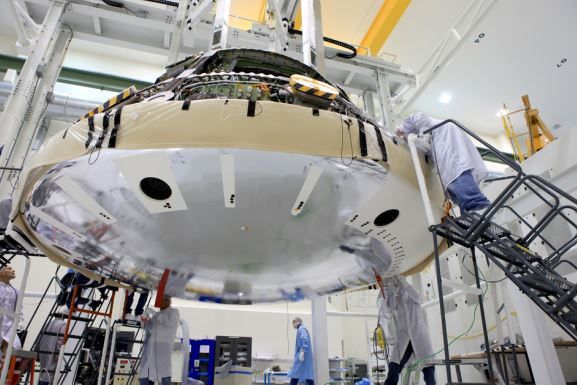Engineers have begun stacking operations for NASA’s maiden Orion deep space test capsule at the Kennedy Space Center (KSC) achieving a major milestone leading to its first blastoff from the Florida Space Coast less than six months from today.
The excitement is mounting as final assembly of NASA’s Orion crew vehicle into its launch configuration started on Monday, June 9, inside the Operations and Checkout (O&C) Facility at Kennedy.
Orion will eventually carry humans to destinations far beyond low Earth orbit on new voyages of scientific discovery in our solar system.
“Orion is the next step in our journey of exploration,” said NASA Associate Administrator Robert Lightfoot at a recent KSC media briefing.
“This mission is a stepping stone on NASA’s journey to Mars. The EFT-1 mission is so important to NASA.”
Orion is slated to launch on its inaugural unmanned test flight in December 2014 atop the mammoth, triple barreled United Launch Alliance (ULA) Delta IV Heavy rocket.
The main elements of the Orion spacecraft stack include the crew module (CM), service module (SM) and the launch abort system (LAS).
On Monday, technicians from Orion’s prime contractor Lockheed Martin began aligning and stacking the crew module on top of the already completed service module in the Final Assembly and System Testing (FAST) Cell in the O & C facility at KSC.
“Ballast weights were added to ensure that the crew module’s center of gravity can achieve the appropriate entry and descent performance and also ensure that the vehicle lands in the correct orientation to reduce structural impact loads,” according to Lockheed Martin.
Engineers will remain busy throughout this week continuing to work at a 24/7 pace to get Orion ready for the December liftoff.
The next steps involve completing the power and fluid umbilical connections between the CM and SM and firmly bolting the two modules together inside the FAST cell.
An exhaustive series of electrical, avionic and radio frequency tests will follow. The team will then conduct final systems checks to confirm readiness for flight.
The LAS will then be stacked on top. The entire stack will then be rolled out to the launch pad for integration with the Delta IV Heavy rocket.
The CM/SM stacking operation was able to move forward following the successful attachment of the world’s largest heat shield onto the bottom of the CM in late May. Read my prior story – here.
“Now that we’re getting so close to launch, the spacecraft completion work is visible every day,” said Mark Geyer, NASA’s Orion Program manager in a statement.
“Orion’s flight test will provide us with important data that will help us test out systems and further refine the design so we can safely send humans far into the solar system to uncover new scientific discoveries on future missions.”
Orion is NASA’s next generation human rated vehicle now under development to replace the now retired space shuttle. The state-of-the-art spacecraft will carry America’s astronauts on voyages venturing farther into deep space than ever before – past the Moon to Asteroids, Mars and Beyond!
[ Original article here ]

